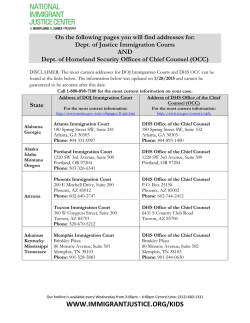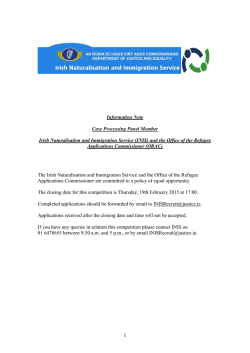
APUSH Immigration Review
APUSH IMMIGRATION REVIEW Ancient and Early Colonial Era (25,000 BCE-1600) I. Early Migration a. Bering Land Bridge had Asians cross into Americas beginning in 25,000 BCE b. After ice melts, Americas established by Asian migrants to become indigenous Americans II. European Exploration and Colonization a. Reasons i. Mercantilism: develop favorable balance of trade ii. Expansion of territory and central authority iii. Christianize and expand the Church b. Spanish claim most of central and southern Americas c. French claim most of Canada d. English make claims on Atlantic seaboard e. Effects of Columbian Exchange on Americas i. Livestock and agriculture affect terrain and environment ii. European diseases, like smallpox decimate 95% of native population iii. Attempt to enslave natives fails due to native knowledge of land for escaping, unreliable labor force, harsh conditions First Wave of Immigrants to America (1600-1800) I. First Settlements in 13 Colonies a. English i. Jamestown established in 1607 developing tobacco plantation system ii. Pilgrims and Puritans establish Massachusetts Bay beginning in 1620 iii. Quakers establish Pennsylvania iv. Catholics establish Maryland b. Dutch i. Settled on Hudson River in 1626 and established New Amsterdam ii. Eventually conquered by British iii. Jewish group arrived from Brazil escaping persecution c. German i. Settled in western frontiers 1. Pennsylvania “Dutch” d. Scot-Irish i. Settled mostly in western frontiers and southern lands ii. Continued to emigrate in western frontier by late 18th century e. Swedish/Finnish i. Established and settled in Delaware lands, but eventually absorbed by British f. Africans i. Forced relocation colonies as slave labor on plantation systems or domestic servants ii. Mostly brought to southern colonies for plantation labor II. Reasons for Immigration a. Displaced economically by modernization and agricultural developments in Europe i. Germans and Scot-Irish b. Religious persecution i. Pilgrims/Puritans in Massachusetts, Catholics in Maryland, Quakers in Pennsylvania c. Social experimentation i. Georgia under James Oglethorpe d. Mercantilist policies of England e. Indentured servants accounted for most of the settlers i. Contracted labor released upon time allowance f. Forced labor such as Africans for plantation systems and domestic servitude III. Adjusting and Adapting to American Colonial Life a. By 1700s, despite cultural and national differences, colonists came to accept English common law, language, systems b. After considerable time, had come to accept each other’s cultures and religion IV. By the Numbers by 1790 a. English descendants numbered 2.1 million in the colonies b. African descendants numbered 757,000 i. Only 7,000 in 1680 c. Scot-Irish/Irish numbered 300,000 d. Germans numbered 200,000 APUSH IMMIGRATION REVIEW Second Wave of Immigrants (1800-1850) I. Northern and Western Europeans a. About 1.5 million Germans emigrated to the Midwest i. Flee political and economical developments in Europe ii. Attracted by farm frontier of the Louisiana Purchase lands iii. Culturally and socially acceptable given Protestant background iv. Suffer prejudice given large numbers and seen as competitive labor and farming force b. Millions of Irish arrive during the 1840s i. Flee potato famine in Ireland ii. Constituted about 35% of immigrant population in mid-19th century iii. Settle mostly in cities since most come from poor tenant farming background iv. Massive influx and Catholicism subject Irish to discrimination and violence II. Mexicans a. After Mexican-American War in 1848, people in Mexican Cession become American citizens overnight III. Africans as Slaves a. International slave trade prohibited in 1808, but smuggling continues from West Indies IV. Asians and Central and South Americans a. California Gold Rush in 1849 leads to massive migration to California and the Pacific West b. 25,000 Chinese settle in U.S. by 1850s V. American Response a. American Party aka Know-Nothing Party i. Nativist platform against immigrants and Catholics ii. Millard Fillmore runs as candidate in 1856 b. Violence i. Immigrants seen as cheap labor thus a competitive labor force along with cultural differences and language barriers led to riots and violence APUSH IMMIGRATION REVIEW Third Wave of Immigrants (1850-1930) I. By the Numbers a. Over 25 million immigrants arrive between 1880 and 1920 b. Most came from Central, Eastern, and Southern Europe along with from Far East Asia II. New Immigrants a. Southern Europeans i. About 5.3 million Italian immigrants from 1880 to 1920 ii. Mostly Catholics b. Eastern Europeans i. Came from Poland, Hungary, Czechoslovakia, Romania, Russia, Baltic nations ii. Consisted of Catholics, Orthodox, and Jews c. Asians III. Economical Response to Immigration a. Gilded Age industrialization led factory owners and corporations to hire immigrants as cheap labor i. Assembly line required less skilled workers b. became solid membership for labor unions such as Knights of Labor c. intend to make money and leave after a few years, but most remained given opportunities IV. Political Response to Immigration a. Political Machines and Bosses i. used ignorance of immigrants to “buy” votes ii. provided jobs and support as long as immigrants voted for a particular party and candidate iii. Tammany Hall and Boss Tweed 1. Democratic stronghold in New York City b. Democrats i. Catered to needs and support for immigrants and minorities c. Immigration Policies i. Ellis Island (1892) and Angel Island (1910) established as immigration processing for political, psychological, and medical testing and inspection ii. Chinese Exclusion Act of 1882 prevented further immigration of Chinese iii. Immigration Act of 1882 excluded lunatics iv. Anarchist Exclusion Act of 1903 prohibited anarchists v. Segregated schools in San Francisco between whites and Asians in 1906 vi. Naturalization Act of 1906 required English for citizenship vii. Dillingham Commission (1907-1911) 1. Southern and Eastern Europeans threatened the American character 2. recommended literacy requirements for immigrants viii. Webb Alien Land Law of California (1913) prohibited non-citizen Asian from owning land ix. Immigration Act of 1917 1. literacy requirement for immigrants over 16 years old 2. included Asiatic Barred Zone and extended list of undesirables x. American Protective League promoted anti-German propaganda during World War I xi. Quota Laws of 1920s 1. Emergency Quota Act of 1921 limited immigration based on 3% of nationality population in 1910 2. National Origins Act of 1924 limited immigration based on 2% of nationality population in 1980 3. excluded Latin American immigrants V. Social Response to Immigration a. Social Darwinism i. White Anglo-Saxon Protestants viewed as the civilized and superior population over nonWASPs b. Nativism and Adjustment i. Anglo-Saxon Americans frowned upon New Immigrants given different cultures such as language and religion ii. Most New Immigrants arrived in worse conditions than previous waves of immigration iii. Ku Klux Klan reestablished in 1915 1. included blacks along with immigrants and Catholics and Jews 2. politically powerful in rural areas in the South and Midwest iv. Sacco and Vanzetti in 1925 case illustrated American prejudice toward New Immigrants c. Urban Life APUSH IMMIGRATION REVIEW i. To escape discrimination and violence, immigrants settled in ethnic neighborhoods 1. Chinatown in San Francisco, Little Italy in New York City ii. Ethnic neighborhoods usually were in the worst parts of the cities 1. tenement buildings cheaply constructed and overpopulated 2. poor sanitation systems led to diseases spreading iii. Settlement houses – Jane Addams and Hull House in Chicago 1. provided daycares, English classes, community centers for poor and immigrants APUSH IMMIGRATION REVIEW Contemporary Immigration (1930-Present) I. 1930s a. Mexican Repatriation i. Great Depression and Dust Bowl forced farmers west and southwest displacing Mexican farmers ii. Federal government repatriated Mexicans to fuel jobs for American farmers II. 1940s a. World War II i. Immigrants fled from war-torn Europe including Germans ii. Jews escaping persecution encountered less acceptance – St. Louis b. Displaced Persons Act i. U.S. allowed immigrants displaced by war to emigrate to America beyond quota law restrictions on a limited basis III. 1950s a. Internal Security Act of 1950 prohibited communist immigrants b. McCarren Walter Immigration Act of 1952 extended national origins system of 1924 IV. 1960s a. Immigration Act of 1965/Hart-Celler Act i. Replaced quota laws with preference categories based on families and job skills V. 1980s a. Mariel Boat Lift to Florida leads to massive Cuban migration b. Immigration Reform and Control Act of 1986 penalizes use of illegal immigrant labor and granted amnesty for illegal immigrants before 1982 c. Demographics i. 47% from Latin America ii. 37% from Asia iii. 12% from Europe and Canada
© Copyright 2025
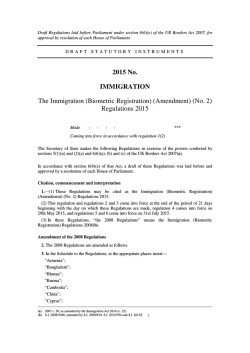
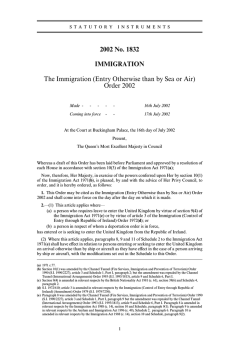
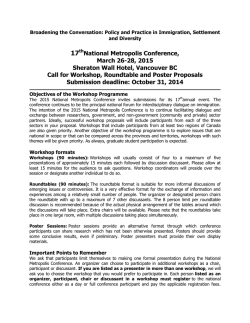
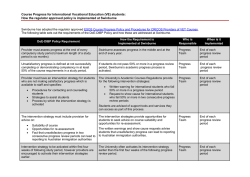
![Part 3: POL[ICE] IN MY HEAD - Undocumented and Uninsured](http://s2.esdocs.com/store/data/001572682_1-e22b907fdfffd79505360f8a293e85ef-250x500.png)
